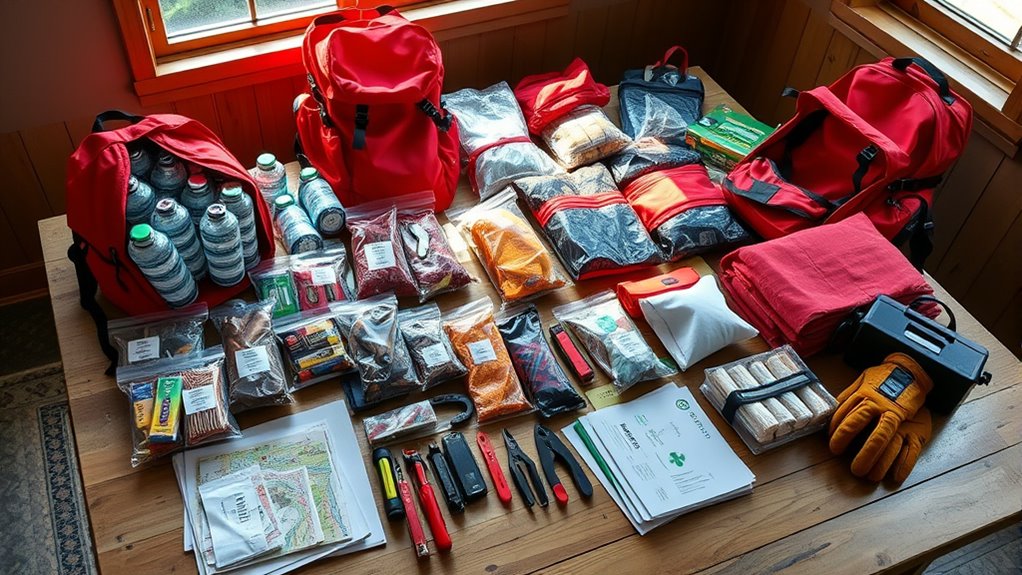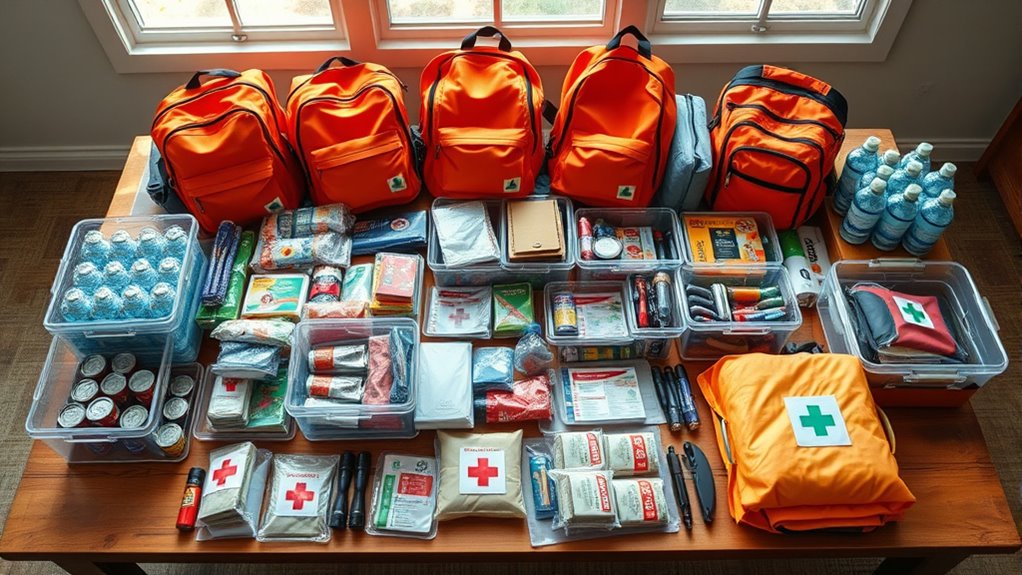A well-prepared emergency kit is your key to safety during unexpected events. Include first aid supplies like bandages, antiseptic wipes, and pain relievers, along with non-perishable food and enough water to last at least three days. Store everything in a portable container and keep supplies updated. Knowing how to use your items and maintaining your kit guarantees you’re ready for any disaster. Keep going to discover tips on building and maintaining your kit effectively.
Key Takeaways
- Include essential supplies like first aid kits, non-perishable food, water, and tools for safety and medical emergencies.
- Regularly review, update, and rotate supplies to ensure freshness and functionality.
- Store the kit in a portable, accessible container and ensure all household members know its location.
- Enhance preparedness with first aid and CPR training to effectively respond during emergencies.
- Label supplies with purchase dates and store in a cool, dry place to maximize shelf life and safety.

An emergency preparedness kit is your essential tool for staying safe during unexpected events. When disaster strikes, having a well-stocked kit can make all the difference in protecting yourself and your loved ones. One crucial component of your kit is first aid supplies. Accidents happen, and being able to treat minor injuries promptly can prevent infections and stabilize more serious wounds until professional help arrives. Keep a comprehensive first aid kit that includes bandages, antiseptic wipes, scissors, tweezers, gloves, and pain relievers. Consider adding items like a triangular bandage for immobilizing sprains or fractures, and a digital thermometer to monitor health status. Regularly check and update your first aid supplies to ensure everything is in working order and within expiration dates. Effective first aid knowledge is just as vital as having the supplies, so consider taking a basic first aid and CPR course to boost your confidence and capabilities during emergencies.
Food storage is another vital aspect of your emergency kit. In a crisis, access to fresh food may be limited, so stocking up on non-perishable items ensures you can sustain yourself and your family for days or even weeks. Opt for canned goods, dried fruits, nuts, granola bars, and ready-to-eat meals that require minimal preparation. Don’t forget to include a manual can opener if your supplies are canned. Water is just as important as food; store at least one gallon per person per day, and keep a supply for at least three days. Consider adding water purification tablets or a portable water filter to your kit, in case you need to source water from natural sources. Proper food storage not only involves having the right items but also storing them in a cool, dry place away from sunlight to maximize shelf life. Label your supplies with purchase dates and rotate stock regularly to prevent spoilage.
Building an effective emergency preparedness kit means paying attention to these critical elements—first aid supplies to handle injuries and food storage to ensure you’re nourished during a crisis. Keep your kit in a portable, accessible container, and make sure everyone in your household knows where it is and how to use its contents. Regularly review and update your kit, adding new supplies and removing expired items. Remember, the goal is to be ready for anything, and a thoughtful, well-maintained kit will give you peace of mind and a better chance of staying safe when disaster strikes.
Frequently Asked Questions
How Often Should I Update My Emergency Kit?
You should update your emergency kit regularly to guarantee kit maintenance and emergency supply rotation. Check it at least every six months to replace expired items, refresh perishable supplies, and update any outdated information. This keeps your kit reliable and ready when needed. Regular maintenance helps you identify missing or damaged items, so you’re always prepared. Make it a habit to review your kit twice a year for peace of mind.
What Items Are Essential for Pets in the Kit?
For your pet’s emergency kit, include pet first aid supplies like bandages and antiseptic wipes, along with pet nutrition such as extra food and water. Don’t forget to add any necessary medications and comfort items. Make certain you have their vaccination records and a leash or carrier. Preparing these essentials helps you care for your pet quickly and effectively during emergencies, keeping them safe and comfortable until help arrives.
Can I Include Medications in My Emergency Kit?
Yes, you can include medications in your emergency kit. Proper medication storage is essential to keep them safe and effective during emergencies. Make sure to pack enough prescription management supplies, like labeled bottles and extra doses, in case you can’t access a pharmacy. Keep medications in a waterproof, easy-to-reach container. Always consult your healthcare provider for specific advice about storing and managing your prescriptions during emergencies.
How Do I Customize a Kit for Children?
Oh, sure, just toss in some crayons and a teddy bear—because nothing says child safety like a plush friend. To truly customize your kit, include kid-friendly essentials like educational materials, snacks, and extra clothing. Remember, children need comfort and security during emergencies, so tailor your supplies to their age and needs. This way, you’re prepared to keep them safe, calm, and maybe even a little entertained amid chaos.
Are There Specific Kits for Different Natural Disasters?
You should consider disaster-specific kits because different natural disasters require tailored emergency supplies. For example, a hurricane kit might include waterproof clothing and extra water, while a wildfire kit could focus on masks and protective gear. By customizing your kits for each disaster type, you guarantee you’re prepared for unique challenges. This approach helps you respond effectively and stay safe during various emergencies.
Conclusion
Now that you’ve packed your emergency kit, you might think you’re completely prepared—only to realize how quickly chaos can strike when you least expect it. Ironically, the very effort to stay safe can remind you of how unpredictable life truly is. So, while it’s great to be prepared, don’t forget: no kit can guarantee safety. Stay alert, stay flexible, and hope you never have to use it—because sometimes, peace of mind is the best emergency supply.









